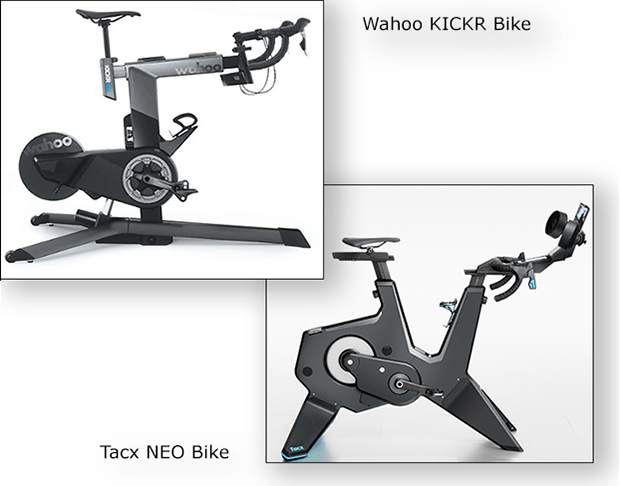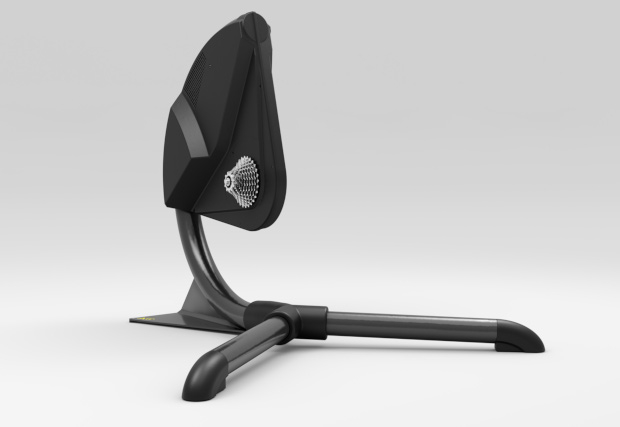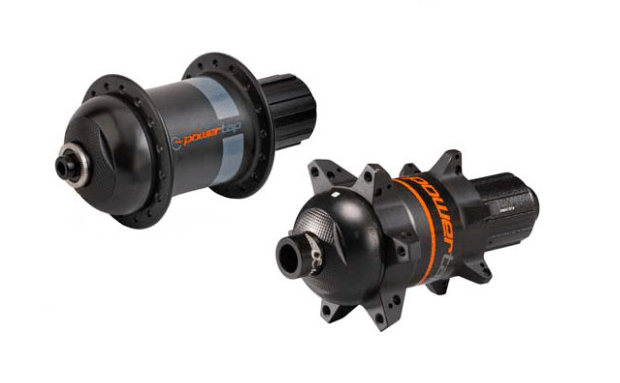Do the NEO Bike and the Garmin Vector 3 Power Numbers Match?
Because I have both a Tacx NEO Bike and a set of Garmin Vector 3 pedals, I thought I’d see how well their power numbers match. This has been discussed a lot in the past, by DC Rainmaker, GPLama, and on the Garmin and Reddit forums and on our Reader Forum. But I haven’t seen much recently. I did see a recent review on Cyclist magazine that reported the Vector 3 highly accurate, and I know that this has not always been the response of reviewers. GPLama (Shane Miller) by his own reckoning has weathered a lot of “drama” with this product, but about a year and-a-half ago he found a new set of Vector 3 pedals quite acceptable (this, a year after his first go at the pedals). So I thought I’d give it a go.
It would be embarrassing for a company making both power meters and smart trainers to suffer big discrepancies between the two, when the two products are used together. To my knowledge Saris escaped ignominy. Its Powertap P1 pedals and Saris’s smart trainers (e.g., the H3) were pretty well spot on according to what I’ve read. Saris sold Powertap to SRAM. Meanwhile, Garmin bought Tacx, so, now this is the company making both products.
I love how GPLama, in his podcasts and blog posts, works his way through problems in real time. He asks the questions and then sometime later in the video or the article answers them. He works through them just like you and I might. But usually a lot quicker than I might. An example of Tacx/Garmin’s lack of congruity between the power meter and the trainer, juxtaposed with Saris’s congruity, can be found in a very early (in the Vector product cycle) GPLama blog post.
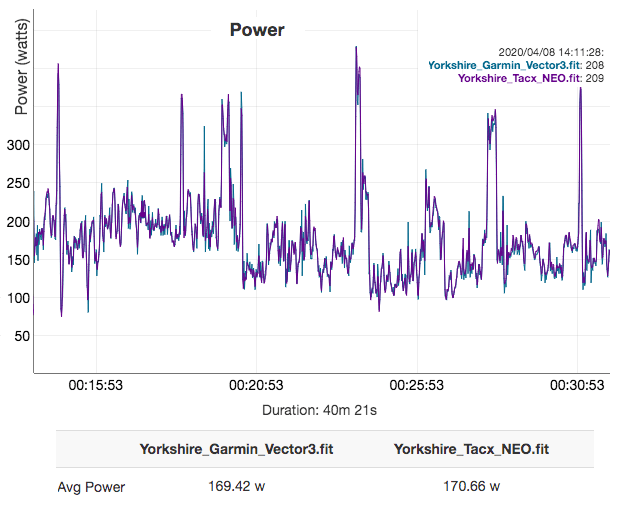
That blog post was in 2017, before Garmin purchased Tacx and Saris offloaded Powertap. To find out how things are now between each of Garmin’s flagship power-producing/measuring products I used the DCR Analyzer, just as Shane did, except in this case I tested Garmin’s Vector 3 pedals against Tacx’s NEO smart bike rather than the standalone NEO smart trainer. I love this bike! This and Wahoo’s KICKR Bike have set the new industry standard for stationary training and I contrasted the two a couple of weeks ago.
I won’t belabor this. There’s the chart, above. The NEO Bike and the Garmin Vector 3 are near spot on. I tested this over 4 rides, and that chart is from the second-most recent ride. The data shown is for the average of the entire ride, about 40 minutes, but the graphed part is truncated due to the limitations of the architecture of our article portal (the DCR Analysis graphs are extra quite). Be aware that I’m not testing through the range of power that GPLama does. He’s testing up to and above 1000 watts. I’m testing to whatever I get to during a ride, in my normal course of riding, which might for a short time, maybe, hit 400 watts if I get a wild hair.
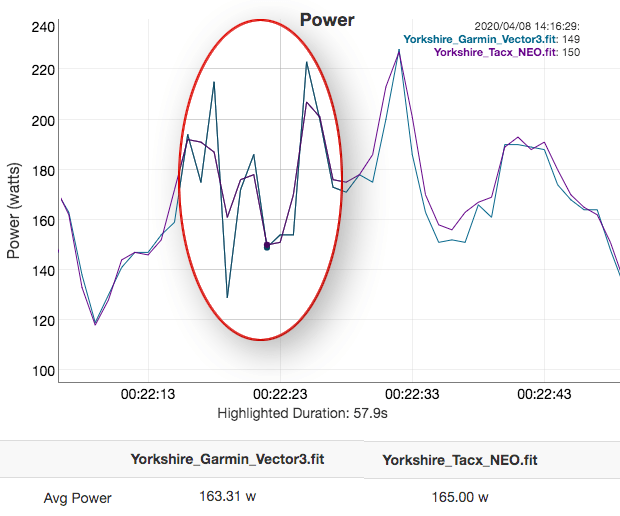
The average watts for the ride are about the same between the pedals and the trainer and I mean within a half a percent between the two. What about 10sec and 3sec averages throughout the ride? No. That’s where the congruity ends. I measured this by taking the DCR Analysis and filtering down to 3sec and 10sec segments throughout the ride. The precision is not there when I attempt to dial up the resolution. Why? If you look at the graph above, there’s a bit of smoothing going on with the NEO Bike that you don’t see with the pedal. I got the pedal’s .fit files from the pedal, and in the case of the NEO Bike I downloaded the .fit files from Zwift. It isn’t Zwift that’s doing the smoothing. They present the data as they get it.
Why do I find congruity between the NEO and the Vector 3 today, since congruity among these products hasn't always been in evidence? The products are different then than now. GPLama, in the 2017 video I linked to above, was running firmware version 2.30 in the Vector 3 pedals and I’m running 3.80 today.
I asked Tacx about differences between the NEO bike and the trainer. I also asked whether one ought to expect the power shown by the pedal to vary from the resistance produced by the trainer, because, someone stomping in a Garmin Vector pedal would have to overcome the resistance produced by the NEO trainer and the mechanical inefficiency of the bike and the drivetrain, it seems to me. The NEO Bike’s drivetrain is virtual. Or has Tacx accounted for this in the way the trainer measures power and produces resistance? I don’t know. I asked. When they tell me I’ll tell you.
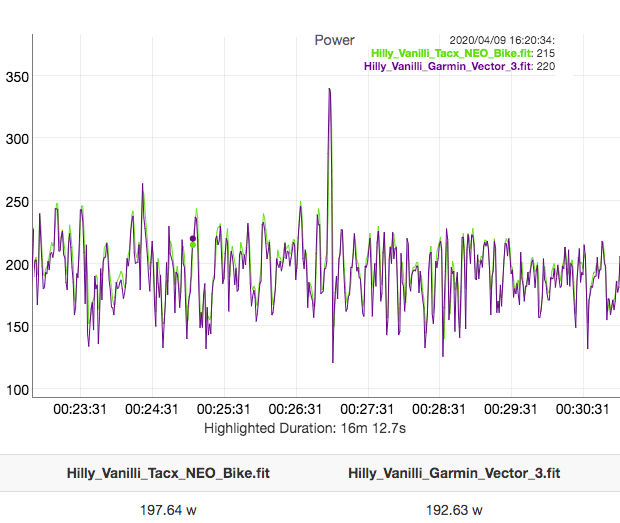
Above is a graph of my last ride. Yesterday. There’s a pretty big variance between the Vector 3 pedal and the NEO Bike. As you see, there’s about a 2.5 percent difference between the bike and the pedal. (You might not think this is a big variance, but I've gotten use to the Vectors matching, to the watt, what Zwift displays for the ride, and Zwift is getting its numbers from the NEO Bike.)
Why this variance in my ride yesterday? I can’t be sure, but this is the one ride where I didn’t zero offset calibrate the pedal before I started the ride. So far, whenever I calibrate before the ride the numbers sync up nicely. When I don’t, I get this variance. If you're new to power meters, don't get freaked out by this. You push the power button on your GPS head unit and it will ask you, do you want to calibrate the pedal? Yes. You place the crankarms horizontal to the ground (which is different than, for example, Shimano, where as I recall the crankarms are to be situated vertical to the ground). You press calibrate. Ten seconds later you're ready to ride.
Why am I even writing this kind of thing, when GPLama and DCRainmaker both do it so much better, and more thoroughly, and with more background, than I can bring to bear? Two reasons. First, because I’m an average person, and if you’re average too sometimes it’s nice to hear from a peer. Second, I have a lot of interesting stuff in my workshop all at one time, right now, temporarily: a NEO Bike; a KICKR Bike; several power meters, including the notorious Dura Ace. I therefore shall, as they say, make hay while the sun shines.


